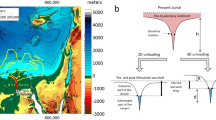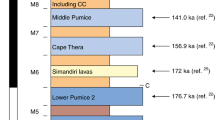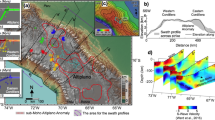Abstract
Between 5 and 6 million years ago, during the so-called Messinian salinity crisis, the Mediterranean basin became a giant salt repository. The possibility of abrupt and kilometre-scale sea-level changes during this extreme event is debated. Messinian evaporites could signify either deep- or shallow-marine deposits, and ubiquitous erosional surfaces could indicate either subaerial or submarine features. Significant and fast reductions in sea level unload the lithosphere, which can increase the production and eruption of magma. Here we calculate variations in surface load associated with the Messinian salinity crisis and compile the available time constraints for pan-Mediterranean magmatism. We show that scenarios involving a kilometre-scale drawdown of sea level imply a phase of net overall lithospheric unloading at a time that appears synchronous with a magmatic pulse from the pan-Mediterranean igneous provinces. We verify the viability of a mechanistic link between unloading and magmatism using numerical modelling of decompression partial mantle melting and dyke formation in response to surface load variations. We conclude that the Mediterranean magmatic record provides an independent validation of the controversial kilometre-scale evaporative drawdown and sheds new light on the sensitivity of magmatic systems to the surface forcing.
This is a preview of subscription content, access via your institution
Access options
Access Nature and 54 other Nature Portfolio journals
Get Nature+, our best-value online-access subscription
$29.99 / 30 days
cancel any time
Subscribe to this journal
Receive 12 print issues and online access
$259.00 per year
only $21.58 per issue
Buy this article
- Purchase on Springer Link
- Instant access to full article PDF
Prices may be subject to local taxes which are calculated during checkout




Similar content being viewed by others
References
Jicha, B., Scholl, D. W. & Rea, D. Circum-Pacific arc flare-ups and global cooling near the Eocene–Oligocene boundary. Geology 37, 303–306 (2009).
Jull, M. & McKenzie, D. The effect of deglaciation on mantle melting beneath Iceland. J. Geophys. Res. 101, 21815–21828 (1996).
Jellinek, A. M., Manga, M. & Saar, M. O. Did melting glaciers cause volcanic eruptions in eastern California? Probing the mechanics of dike formation. J. Geophys. Res. 109, B09206 (2004).
Huybers, P. & Langmuir, C. Feedback between deglaciation, volcanism, and atmospheric CO2 . Earth Planet. Sci. Lett. 286, 479–491 (2009).
Crowley, J. W., Katz, R. F., Huybers, P., Langmuir, C. & Park, S.-H. Glacial cycles drive variations in the production of oceanic crust. Science 347, 1237–1240 (2015).
Sternai, P., Caricchi, L., Castelltort, S. & Champagnac, J.-D. Deglaciation and glacial erosion: a joint control on magma productivity by continental unloading. Geophys. Res. Lett. 43, 1–10 (2016).
McGuire, W. J. et al. Correlation between rate of sea-level change and frequency of explosive volcanism in the Mediterranean. Nature 389, 473–476 (1997).
Gautier, F., Clauzon, G., Suc, J. P., Cravatte, J. & Violanti, D. Age et durée de la crise de salinité messinienne. C. R. Acad. Sci. 318, 1103–1109 (1994).
Hsü, K. J., Ryan, W. B. & Cita, M. Late Miocene desiccation of the Mediterranean. Nature 242, 240–244 (1973).
Ogniben, L. Petrografia della Serie Solfifera Siciliana e considerazioni geologiche relative. Mem. Descr. Carta Geol. Ital. 22, 1–275 (1957).
Perrodon, A. Etude géologique des bassins néogènes sublittoraux de l’Algérie occidentale. Bull. Serv. Carte Géol. Algér 12, 328 (1957).
Clauzon, G., Suc, J. P., Gautier, F., Berger, A. & Loutre, M. F. Alternate interpretation of the Messinian salinity crisis: controversy resolved? Geology 24, 363–366 (1996).
Roveri, M. et al. Dense shelf water cascading and Messinian canyons: a new scenario for the Mediterranean salinity crisis. Am. J. Sci. 314, 751–784 (2014).
Lugli, S., Manzi, V., Roveri, M. & Schreiber, B. The deep record of the Messinian salinity crisis: evidence of a non-desiccated Mediterranean Sea. Palaeogeogr. Palaeoclimatol. Palaeoecol. 297, 83–99 (2015).
Urgeles, R. et al. New constraints on the Messinian sealevel drawdown from 3D seismic data of the Ebro Margin, western Mediterranean. Basin Res. 23, 123–145 (2011).
Roveri, R. et al. The Messinian salinity crisis: past and future of a great challenge for marine sciences. Mar. Geol. 352, 25–58 (2014).
Hsü, K. J., Cita, M. & Ryan, B. in Initial Reports of the Deep Sea Drilling Project Vol. 13 (eds Ryan, W. F. B. & Hsü, K. J. et al.) 1203–1231 (US Government Printing Office, 1973).
Ryan, W. B. Modeling the magnitude and timing of evaporative drawdown during the Messinian salinity crisis. Stratigraphy 5, 227–243 (2008).
Ryan, W. B. & Cita, M. B. The nature and distribution of Messinian erosional surfaces—indicators of a several-kilometer-deep Mediterranean in the Miocene. Mar. Geol. 27, 193–230 (1978).
Ryan, W. B. Geodynamic responses to a two-step model of the Messinian salinity crisis. Bull. Soc. Géol. Fr. 182, 73–78 (2011).
Jolivet, L., Augier, R., Robin, C., Suc, J. P. & Rouchy, J. M. Lithospheric-scale geodynamic context of the Messinian salinity crisis. Sediment. Geol. 188–189, 9–33 (2006).
Duggen, S., Hoernle, K., van den Bogaard, P. & Harris, C. Magmatic evolution of the Alboran region: the role of subduction in forming the western Mediterranean and causing the Messinian Salinity Crisis. Earth Planet. Sci. Lett. 218, 91–108 (2004).
Jolivet, L. & Brun, J.-P. Cenozoic geodynamic evolution of the Aegean. Int. J. Earth Sci. 99, 109–138 (2010).
Serri, G. F., Innocenti, F. & Manetti, P. Geochemical and petrological evidence of the subduction of delaminated Adriatic continental lithosphere in the genesis of the Neogene–Quaternary magmatism of Central Italy. Tectonophysics 223, 117–147 (1993).
Bache, F. et al. A two step process for the reflooding of the Mediterranean after the Messinian Salinity Crisis. Basin Res. 24, 125–153 (2012).
Ghiorso, M. S., Hirschmann, M. M., Reiners, P. W. & Kress, V. C. The pMELTS: a revision of MELTS for improved calculation of phase relations and major element partitioning related to partial melting of the mantle to 3 GPa. Geochem. Geophys. Geosyst. 3, 1–35 (2002).
Tumanian, M., Frezzotti, M. L., Peccerillo, A., Brandmayr, E. & Panza, G. Thermal structure of the shallow upper mantle beneath Italy and neighbouring areas: correlation with magmatic activity and geodynamic significance. Earth-Sci. Rev. 114, 369–385 (2012).
Jolivet, L. et al. Ductile extension in alpine Corsica. Geology 18, 1007–1010 (1990).
Turcotte, D. L. & Schubert, G. Geodynamics (Cambridge Univ. Press, 2002).
Turcotte, D. L. & Ahern, J. L. A porous flow model for magma migration in the asthenosphere. J. Geophys. Res. 83, 767–772 (1978).
Rubin, A. M. Tensile fracture of rock at high confining pressure: implications for dike propagation. J. Geophys. Res. 98, 15919–15935 (1993).
Olive, J.-A. et al. Sensitivity of seafloor bathymetry to climate-driven fluctuations in mid-ocean ridge magma supply. Science 350, 310–313 (2015).
Gargani, J. & Rigollet, C. Mediterranean sea level variations during the Messinian salinity crisis. Geophys. Res. Lett. 34, 10 (2007).
Garcia-Castellanos, D. & Villaseñor, A. Messinian salinity crisis regulated by competing tectonics and erosion at the Gibraltar arc. Nature 480, 359–363 (2011).
Jolivet, L. & Faccenna, C. Mediterranean extension and the Africa–Eurasia collision. Tectonics 19, 1095–1106 (2000).
Krijgsman, W. & Garcés, M. Paleomagnetic constraints on the geodynamic evolution of the Gibraltar Arc. Terra Nova 16, 281–287 (2004).
Malinverno, A. & Ryan, W. B. Extension in the Tyrrhenian Sea and shortening in the Apennines as result of arc migration driven by sinking of the lithosphere. Tectonics 5, 227–245 (1986).
Jolivet, L. et al. Subduction, convergence and the mode of backarc extension in the Mediterranean region. Bull. Soc. Géol. Fr. 179, 525–550 (2008).
Duggen, S., Hoernle, K., Van Den Bogaard, P., Rüpke, L. & Morgan, J. P. Deep roots of the Messinian salinity crisis. Nature 422, 602–606 (2003).
Pe-Piper, G. & Piper, D. J. Postcollisional Tectonics and Magmatism in the Mediterranean Region and Asia (eds Dilek, Y. & Pavlides, S.) 259–282 (Geological Society of America, 2006).
Jolivet, L. et al. The geological signature of a slab tear below the Aegean. Tectonophysics 659, 166–182 (2015).
Sternai, P., Jolivet, L., Menant, A. & Gerya, T. Driving the upper plate surface deformation by slab rollback and mantle flow. Earth Planet. Sci. Lett. 405, 110–118 (2014).
Menant, A., Sternai, P., Jolivet, L., Guillou-Frottier, L. & Gerya, T. V. 3D numerical assessments for mantle flow and magma genesis in laterally constrained subduction zones: the eastern Mediterranean case study. Earth Planet. Sci. Lett. 442, 93–107 (2016).
Blanc, P. L. Of sills and straits: a quantitative assessment of the Messinian Salinity Crisis. Deep Sea Res. Part I 47, 1429–1460 (2000).
Millero, F., Chen, C., Bradshaw, A. & Schleicher, K. A new high pressure equation of state for seawater. Deep-Sea Res. A 27, 255–264 (1980).
Govers, R. Choking the Mediterranean to dehydration: the Messinian salinity crisis. Geology 37, 167–170 (2009).
von Blanckenburg, F. & Huw Davies, J. Slab breakoff: a model for syncollisional magmatism and tectonics in the Alps. Tectonics 1, 120–131 (1995).
McKenzie, N. R. et al. Continental arc volcanism as the principal driver of icehouse–greenhouse variability. Science 352, 444–447 (2016).
Gerya, T. Introduction to Numerical Geodynamic Modelling (Cambridge Univ. Press, 2010).
Schmidt, P. et al. Effects of present-day deglaciation in Iceland on mantle melt production rates. J. Geophys. Res. 118, 3366–3379 (2013).
Acknowledgements
P.S. is grateful to the Swiss NSF for providing funding for this project (Ambizione grant PZ00P2_168113/1). L.C. and T.E.S. were funded by the European Research Council (ERC) under the European Union’s Horizon 2020 research and innovation programme (grant agreement No. 677493 — FEVER). D.G.-C. was funded by the MITE CGL2014-59516 (Spanish Government). S.C. was funded by Swiss NSF grant No. 200021–146822. J.-A. Olive is thanked for helpful suggestions regarding Fig. 3 and all related aspects.
Author information
Authors and Affiliations
Contributions
P.S. conceived the scientific question, designed and performed the work and wrote the manuscript. L.C. contributed to the conception of the scientific question and helped with the MELTS modelling. D.G.-C. and L.J. provided fundamental insights into the available knowledge about the MSC as well as the Mediterranean geodynamics and magmatism. T.E.S. helped with the statistical treatment of data. S.C. contributed to the conception of the scientific question. All authors contributed to the design of the work and improved the manuscript.
Corresponding author
Ethics declarations
Competing interests
The authors declare no competing financial interests.
Supplementary information
Supplementary Information
>Supplementary Information (PDF 422 kb)
Supplementary Information
>Supplementary Information (XLSX 15 kb)
Rights and permissions
About this article
Cite this article
Sternai, P., Caricchi, L., Garcia-Castellanos, D. et al. Magmatic pulse driven by sea-level changes associated with the Messinian salinity crisis. Nature Geosci 10, 783–787 (2017). https://doi.org/10.1038/ngeo3032
Received:
Accepted:
Published:
Issue Date:
DOI: https://doi.org/10.1038/ngeo3032
This article is cited by
-
The build-up and triggers of volcanic eruptions
Nature Reviews Earth & Environment (2021)
-
Eruptive activity of the Santorini Volcano controlled by sea-level rise and fall
Nature Geoscience (2021)
-
Efficient recycling of nutrients in modern and past hypersaline environments
Scientific Reports (2019)
-
Global time-size distribution of volcanic eruptions on Earth
Scientific Reports (2018)
-
The Alboran volcanic-arc modulated the Messinian faunal exchange and salinity crisis
Scientific Reports (2018)



